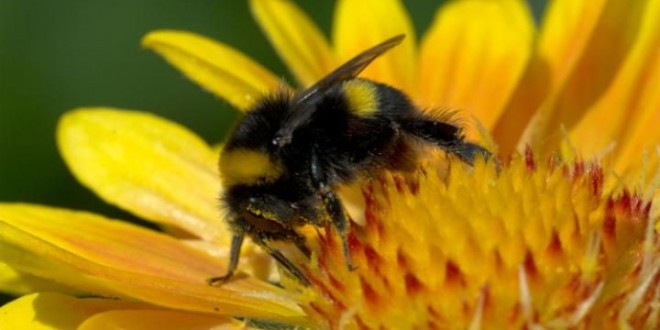Bees visit flowers to collect nectar and pollen, which they use as food for themselves and the larvae in their hives or nests. By moving from flower to flower, they are vital pollinators of many garden and wild flowers. Insect pollination is essential for the cropping of most fruits and some vegetables.
Some 35 per cent of our diet depends on pollination of crops by bees and it is often said that if bees died out, humans would follow just four years later, a view sometimes attributed to Albert Einstein.
There are two main types of bee; the Bumblebee and the Honeybee. Populations of both have suffered huge declines in recent years for a number of different reasons so it is worth knowing the difference.
Bumblebees
They are easily recognised by their characteristic fluffy bodies. Different species of Bumblebee have different length tongues because they feed from different shaped flowers. Our wild Bumblebees have suffered declines due to bad weather, the use of insecticides and a reduction in wildflower rich grassland for feeding and nesting.
Honeybees
There is only 1 species of Honeybee in Europe and these bees live in hives that are cultivated and tended by beekeepers in order to produce honey. Britain’s cultivated honeybee population has been largely affected by the varroa mite, which has spread rapidly through bee hives since arriving in Britain in 1992. Honeybees are slimmer and smaller than Bumblebees, having a closer appearance to a wasp. They all have short tongues which are best suited to feeding from open flower shapes.
Encouraging Bumblebees in the garden.
If you are encouraging bees into your garden then it is important to avoid using insecticides as these will kill helpful pollinating insects (including bees) as well as the target insects.
How to make a bee house.
Remember that different species require different habitats. Mason Bees enjoy nesting holes in wood or thick stems. You can make your own simple bee house or you can buy a commercially made bee house. Use hollow bamboo canes, dried Japanese knotweed stems or even thick bramble stems. Fix bee boxes in a south-facing spot but not in direct sunlight. Also make sure the entrance points downwards so that rain does not get in.
Many other species of bumblebee will prefer a wood pile in your garden. Simply create a pile of logs, stems and branches and leave it be – the more untidy, the better! Other species will enjoy a grassy bank to nest it – let the grass grow tall and plant pollen rich plants along the edge of the bank.
Planting flowers for bees.
It’s best to aim for a good variety of pollen rich flowers that have different flower shapes and a range of flowering periods from early spring to late summer. Try to ensure at least two different plant species in flower at any time throughout this period to prevent your bees from going hungry. Most double flower forms are lacking in pollen or nectar and likely to be inaccessible to bees so these are best avoided.
Agencies/Canadajournal
 Canada Journal – News of the World Articles and videos to bring you the biggest Canadian news stories from across the country every day
Canada Journal – News of the World Articles and videos to bring you the biggest Canadian news stories from across the country every day




Do you want to attract bees to your garden?Stop using Monsanto products.That’s a good start.